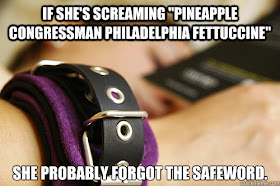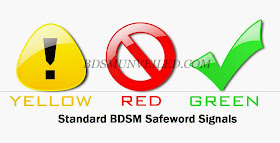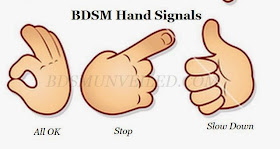What is a safeword? When is it used? Why would a person use it? I've written about safe words in various posts, but more in depth in my Limits in BDSM article. Recently, the topic has come up in various groups, so I decided to write a comprehensive article about them.
A safeword is a code word or series of code words that are sometimes used for a submissive to communicate their physical or emotional state to a dominant, typically when approaching, or crossing, a physical, emotional, or moral boundary.
Some safewords are used to stop the scene outright, while others can communicate a willingness to continue, but at a reduced level of intensity. Safewords are usually agreed upon before playing a scene by all participants, and many organized BDSM groups have standard safewords that all members agree to use to avoid confusion at organized play events.
There are many advantages to having a safeword. The first is that sexual experimentation with your partner should always feel fun and safe. Whether you're tying each other to the bedposts or role-playing for the first time, establishing a safeword makes both partners comfortable that the situation can end at any sign of discomfort.
Safewords of BDSM falls under the guiding philosophy of safe, sane and consensual (SSC). Those who practice the more permissive philosophy of risk-aware consensual kink (RACK) may abandon the use of safewords, especially those that practice forms of edgeplay or extreme forms of dominance and submission. In such cases, the choice to give up the use of safewords is a consensual act on the part of the submissive and excepted by the Dominant.
There are many advantages to having a safeword. The first is that sexual experimentation with your partner should always feel fun and safe. Whether you're tying each other to the bedposts or role-playing for the first time, establishing a safeword makes both partners comfortable that the situation can end at any sign of discomfort.
Safewords of BDSM falls under the guiding philosophy of safe, sane and consensual (SSC). Those who practice the more permissive philosophy of risk-aware consensual kink (RACK) may abandon the use of safewords, especially those that practice forms of edgeplay or extreme forms of dominance and submission. In such cases, the choice to give up the use of safewords is a consensual act on the part of the submissive and excepted by the Dominant.
When you and your partner establish a safeword, you need to choose something that is easy for both of you to remember, no matter what is going on. The safeword needs to be free of sexual connotations. "No" and "stop" make bad safewords, because those are words that might be said as part of sex play. For example, if you and your partner go to a bar and one of you is pretending to pick up the other as a stranger, "Stop hitting on me," or "No, I won't go home with you" are potentially confusing if "no" or "stop" is the safeword.
Since a scene may become too intense for a submissive partner to remember what the safeword is, in practice commonly the words safeword or red are also used as safewords. They are often the default at many play parties, or respected as a safeword in addition to any negotiated safeword. A dungeon monitor would likely expect either of those words to be respected.
Some partners may also have different gradations of safewords, such as green to mean "Okay" or even "harder" or "more", yellow to mean "slow down" or "stop doing that" without stopping the scene, and red to mean "stop the scene". In this fashion, a dominant partner may ask the submissive partner "What is your color?" to check with a submissive partner without having to stop the scene.
If your partner says the safe word, you need to stop whatever you are doing. Immediately remove yourselves from the sexual aspect of the situation. A safeword is usually used by the bottom, but can be used by all participants in a scene, including tops, dungeon masters at play parties, and sometimes even observers.
For example, a bottom may misbehave intentionally to indicate the desire for harsher treatment, and sometimes a top will need to safeword the scene to let them know it has gone too far for the top to continue the scene. Or, a third party observing a scene may have the ability to spot something dangerous going on that both the top and bottom have missed, and need to stop the scene to point it out.
If a submissive is gagged and unable to speak during a scene, you and your partner need to agree on a couple of hand signals that are easy to use and remember. During the a scene of this nature, the dominant needs to stop periodically and check in with the submissive to ensure the sub is ok to continue.
If and when your partner feels comfortable, talk about what went wrong or what made your partner uneasy. Do not press for an explanation, though, because the whole reason the safe word exists is to eliminate the need for an explanation to stop a scenario. Likewise, if you are the one to say the safe word, your partner must immediately respect your need to stop.
Remember, choose something odd but that you both remember and always respect your partner by stopping immediately if the safeword is used.
Safewords in BDSM









Thank you fur mentioning the hand signals. We had to institute soft words as well, for slowing down or ratcheting off the intensity without ending a scene. It worked well for us.
ReplyDeleteGreat article :)
See you on g+ ;)
.